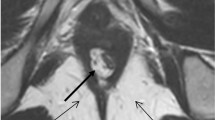Abstract
Background
Postoperative anorectal malformation patients frequently have defecatory dysfunction. MRI may be useful in the management of these patients.
Objective
To analyze static and dynamic MRI findings in patients with defecatory dysfunction after correction of anorectal malformation (ARM), and compare differences between patients with constipation and fecal incontinence.
Materials and methods
Pelvic MRI studies of 20 constipated and 32 incontinent postoperative ARM patients were analyzed retrospectively to determine the location and morphology of the neorectum, presence of peritoneal fat herniation, presence of scarring, development of the striated muscle complex (SMC) and any other abnormalities. The two groups were then compared using χ 2-test. Eighteen patients also underwent MRI defecography to evaluate pelvic floor function and abnormalities are reported.
Results
The children with incontinence were more likely to have abnormal location of the neorectum (P = 0.031), increased anorectal angle (ARA) (P = 0.031) and peritoneal fat herniation (P = 0.032), and less likely to have dilation of the neorectum (P = 0.027), than the children with constipation. There were no significant differences between the two groups in incidence of focal stenosis of the neorectum (P = 0.797), presence of extensive scarring (P = 0.591) and developmental agenesis of the SMC (P > 0.05). MRI defecography showed 6 anterior rectoceles, 6 cystoceles and 18 pelvic floor descents.
Conclusions
MRI is a helpful imaging modality in postoperative ARM patients with defecatory dysfunction, and it shows distinct differences between the children with constipation and incontinence and provides individualized information to guide further treatment.










Similar content being viewed by others
References
Rintala RJ, Lindahl HG (2001) Fecal continence in patients having undergone posterior sagittal anorectoplasty procedure for a high anorectal malformation improves at adolescence, as constipation disappears. J Pediatr Surg 36:1218–1221
Boemers TM, Ludwikowski B, Forstner R et al (2006) Dynamic magnetic resonance imaging of the pelvic floor in children and adolescents with vesical and anorectal malformations. J Pediatr Surg 41:1267–1271
McHugh K (1998) The role of radiology in children with anorectal anomalies; with particular emphasis on MRI. Eur J Radiol 26:194–199
Eltomey MA, Donnelly LF, Emery KH et al (2008) Postoperative pelvic MRI of anorectal malformations. AJR Am J Roentgenol 191:1469–1476
Wang DY, Qiu XH, Li L (1999) Morphological study of puborectalis and anal sphincter in anorectal anomaly with CT. Chin J Pediatr Surg 20:15–17
deVries PA, Cox KL (1985) Surgery of anorectal anomalies. Surg Clin North Am 65:1139–1169
EI Sayed RF, EI Mashed SM, Farag A et al (2008) Pelvic floor dysfunction: assessment with combined analysis of static and dynamic MR imaging findings. Radiology 248:518–530
Levitt MA, Pena A (2007) Anorectal malformations. Orphanet J Rare Dis 2:33–45
Stoker J (2009) Anorectal and pelvic floor anatomy. Best Pract Res Clin Gastroenterol 23:463–475
Goei R (1990) Anorectal function in patients with defecation disorders and asymptomatic subjects: evaluation with defecography. Radiology 174:121–123
Bajwa A, Emmanuel A (2009) The physiology of continence and evacuation. Best Pract Res Clin Gastroenterol 23:477–485
Madoff RD, Parker SC, Varma MG et al (2004) Fecal incontinence in adults. Lancet 364:621–632
Kubora M, Suita A (2002) Assessment of sphincter muscle function before and after posterior sagittal anorectoplasty using a magnetic spinal stimulation technique. J Pediatr Surg 37:617–722
Nievelstein RA, Vos A, Valk J et al (2002) Magnetic resonance imaging in children with anorectal malformations: embryologic implications. J Pediatr Surg 37:1138–1145
McHugh K, Dudley NE, Tam P (1995) Preoperative MRI of anorectal anomalies in the newborn period. Pediatr Radiol 25:33–36
Fukuya T, Honda H, Kubota M et al (1993) Postoperative MRI evaluation of anorectal malformation with clinical correlation. Pediatr Radiol 25:583–586
Fynes MM, Marshall K, Cassidy M et al (1999) A prospective, randomized study comparing the effect of augmented biofeedback with sensory biofeedback alone on fecal incontinence after obstetric trauma. Dis Colon Rectum 42:753–758
Acknowledgments
This research supported by Natural Science Foundation of Shandong Province, NO. ZR2010HL055.
Conflict of interest
The authors declare no conflicts of interest.
Author information
Authors and Affiliations
Corresponding author
Rights and permissions
About this article
Cite this article
Yong, C., Ruo-yi, W., Yuan, Z. et al. MRI findings in patients with defecatory dysfunction after surgical correction of anorectal malformation. Pediatr Radiol 43, 964–970 (2013). https://doi.org/10.1007/s00247-013-2639-8
Received:
Revised:
Accepted:
Published:
Issue Date:
DOI: https://doi.org/10.1007/s00247-013-2639-8




